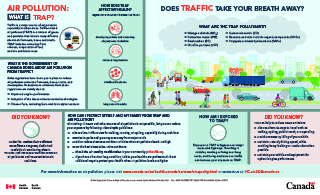Does traffic take your breath away?
Air pollution: What is TRAP?
Traffic is a major source of air pollution especially in urban areas. Traffic-related air pollution (TRAP) is a mixture of gases and particles that include many different chemicals from cars, buses and trucks. TRAP includes emissions from exhaust, evaporation of fuel, and tire and brake wear.
What are the TRAP pollutants?
- Nitrogen dioxide (NO2)
- Particulate matter (PM)
- Black carbon (BC)
- Ultrafine particles (UFP)
- Carbon monoxide (CO)
- Benzene and other volatile organic compounds (VOCs)
- Polycyclic aromatic hydrocarbons (PAHs)
How am I exposed to TRAP?
Exposure to TRAP is highest near major roads and highways. Travelling in vehicles, working or living near busy roads, and being outdoors near traffic can increase your exposure to TRAP.
How does TRAP affect my health?
Exposure to TRAP can increase the risk of:
- developing asthma and worsening of symptoms in children
- reduced lung function
- childhood leukemia
- lung cancer in adults
What is the Government of Canada doing about air pollution from traffic?
Strict regulations have been put in place to reduce air pollutant emissions from cars, buses, trucks, and motorcycles. Reductions in emissions from these regulations are mainly due to:
- Improved engine performance
- Adoption of the latest emission control technologies
- Cleaner fuels, including fuels with low sulphur content
Did you know?
Under the National Air Pollutant Surveillance Program, dedicated roadside air monitoring sites in Toronto and Vancouver monitor common air pollutants and TRAP emissions in real-time.
How can I protect myself and my family from TRAP and air pollution?
Eliminating all TRAP and other sources of air pollution is not possible, but you can reduce your exposure by following a few simple guidelines:
- Choose low-traffic routes for walking, running, or cycling, especially during rush hour
- Exercise in parks and green spaces away from major roads
- Avoid or reduce strenuous outdoor activities when air pollution levels are high
- Know the best times to be active outdoors:
- Check the Air Quality Health Index in your community (airhealth.ca)
- If you have a heart or lung condition, talk to your health care professional about additional ways to protect your health when air pollution levels are higher
Did you know?
You can help to reduce TRAP emissions:
- Choose alternate ways to travel such as walking, cycling, public transit, or carpooling
- Avoid unnecessary idling of your vehicle
- Maintain a steady driving speed, while avoiding heavy braking or acceleration when possible
- Maintain your vehicle and equipment for optimal engine performance
For more information, please visit the Air quality and health page or contact us at: HC.air.SC@canada.ca
Page details
- Date modified:
